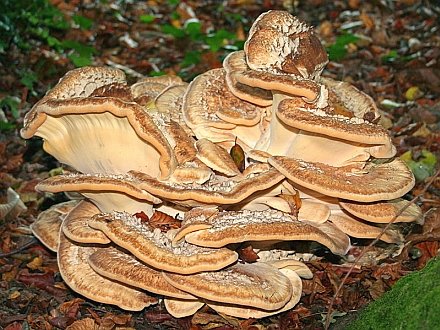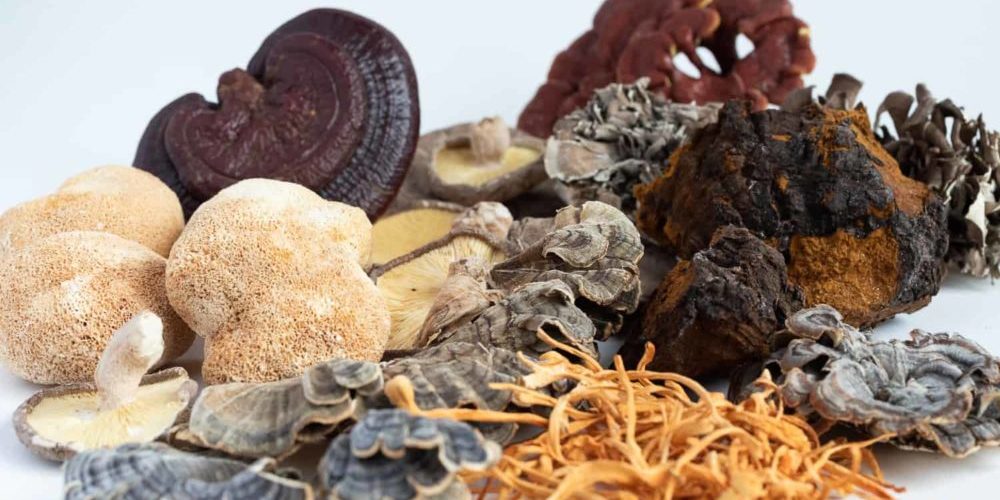The giant polypore, Meripilus giganteus (Pers.) P. Karst.
Synonyms
Agaricus aequivocus (Holmsk.) E.H.L. Kraus
Agaricus multiplex Dill.
Boletus acanthoides Bull.
Boletus giganteus Pers.
Caloporus acanthoides (Bull.) Quél.
Cladomeris acanthoides (Bull.) Quél.
Cladomeris giganteus (Pers.) Quél.
Clavaria aequivoca Holmsk.
Flabellopilus giganteus (Pers.) Kotl. & Pouzar
Grifola acanthoides (Bull.) Pilát
Grifola gigantea (Pers.) Pilát
Grifola lentifrondosa Murrill
Meripilus lentifrondosus (Murrill) M.J. Larsen & Lombard [as ‘lentifrondosa‘]
Merisma acanthoides (Bull.) Gillet
Merisma giganteum (Pers.) Gillet
Polypilus frondosus var. intybaceus (Fr.) Bondartsev
Polypilus giganteus (Pers.) Donk
Polyporus acanthoides (Bull.) Fr.
Polyporus acanthoides Rostk.
Polyporus aequivocus (Holmsk.) E.H.L. Krause
Polyporus frondosus Fr.
Polyporus giganteus (Pers.) Fr.
Polyporus lentifrondosus (Murrill) Murrill
Common name
Giant polypore
Description
The basidiomycete Meripilus giganteus occurs in the living trees of several genera, and causes a white rot of the butt and roots.
Fruiting body: annual; 50-80 cm diameter, pileate with fan-shaped to spathulate caps originating from a common base; aggregates of caps can be up to 1 m in diameter and 70 kg fresh weight; individual caps 10-30 cm diameter, 1-2 cm thick; upper cap surface cream white to yellow-brown, zonate; pore surface cream to yellow-orange-brown pores (3 to 5 per mm), rapidly turning blackish when bruised or cut.
Spores: 5.5-6.5 x 4-5 µm, subglobose, hyaline.
Edibility: edible, but with a sour taste and fibrous texture, palatability is questionable; younger, more tender specimens are to be preferred.
Habit and Habitat: on stumps of freshly felled trees and at the base of standing strees; often apparently growing from the ground, but always in contact with wood; circumboreal in the northern hemisphere, usually found on hardwoods, particularly horse chestnut (Aesculus), beech (Fagus), lime (Tilia) and oak (Quercus).

My name is Austin Collins.
I've dedicated my life to Mushrooms.
I believe Mushrooms are the best kept secret when it comes to health and well being.
For that reason, I would like to share a company with you that in my opinion makes the best mushroom products on the market.
The company is called Noomadic Herbals, my favorite supplement they make is called "Mushroom Total".
I take their products every day and they have helped me think better and have more energy. Give them a try.
-Austin
Medicinal properties
Immunosuppressive effects
In the methanolic extract of Meripilus giganteus a mixture of saturated and unsaturated fatty acids (among them palmitic, oleic and linoleic acid) and ergosterol peroxide were identified as immunosuppressive components. Furthermore, a homologous series of straight-chained saturated hydrocarbons with 22 to 26 and 29 to 32 C-atoms were identified (Narbe et al.,1991). However, when tested for immunosuppressive activity, various mushroom extracts were not active in the assay system used (Koch et al., 2002). In these experiments, the assay was based on the ability of the extract to inhibit the binding of endotoxin to CD14+ cells and to influence LPS-induced release of proinflammatory cytokines (IL-1β, IL-6, TNF-α), regulatory cytokines (IL-2, IL-4, IL-10, IFN-γ), and the release of reactive oxygen species; these are physiological responses consistent with hypersensitivity reactions, like asthma.
A crude methanol extract from this species was shown to have significant cytotoxic activity against murine cancer cell line 3LL (Lewis lung carcinoma), with an IC50 of 19.8 ±2.6 µg/ml (Tomasi et al., 2004).
Links
Mushroom Expert
Learn more about the Giant polypore’s life history here and here.
BioPix has a nice gallery of photos.
References
Bhavanandan VP, Lindberg B, Bouveng HO.
Polysaccharides from Polyporus giganteus.
Acta Chemica Scandinavica. 1964 18(2):504-12.
Koch J, Witt S, Lindequist U.
The influence of selected higher Basidiomycetes on the binding of lipopolysaccharide to CD14+ cells and on the release of cytokines.
Int J Med Mush. 2002 4(3):229-35.
Larsen MJ, Lombard FF.
The status of Meripilus giganteus (Aphyllophorales, polyporaceae) in North America.
Mycologia. 1988 80(5):612-21.
Narbe G, Lindequist U, Teuscher E.
Immunosuppressive activities of Meripilus giganteus (Pers Fr) Karst.
Pharmazie. 1990 45(8):637-8.
Narbe G, Lindequist U, Teuscher E, Franke P, Vainiotalo P, Basner R.
Studies of the chemistry of immunosuppressive active fractions from Meripilus giganteus (Pers ex Fr.) Karst.
Pharmazie. 1991 46(10):738-40.
Ohtsuka S, Ueno S, Yoshikumi C, Hirose F, Ohmura Y, Wada T, Fujii T, Takahashi E.
Polysaccharides having an anticarcinogenic effect and a method of producing them from species of Basidiomycetes.
UK Patent 1331513, 26 September 1973.
Tomasi S, Lohezic-Le Devehat F, Sauleau P, Bezivin C, Boustie J.
Cytotoxic activity of methanol extracts from Basidiomycete mushrooms on murine cancer cell lines.
Pharmazie. 2004 59(4):290-3.



